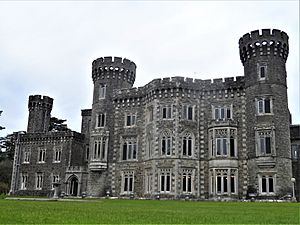Johnstown Castle facts for kids
Quick facts for kids Johnstown Castle |
|
|---|---|
| Native name Irish: Caisleán Bhaile Sheáín |
|
 |
|
| Type | Castle |
| Location | Johnstown, Murntown, County Wexford, Ireland |
| Built | late 12th century (original building) 1836–1872 (current building) |
| Architectural style(s) | Gothic Revival |
| Owner | Irish Heritage Trust |
| Lua error in Module:Location_map at line 420: attempt to index field 'wikibase' (a nil value). | |
Johnstown Castle is a Gothic Revival castle located in County Wexford, Ireland.
Location
Johnstown Castle is located on the Johnstown Castle Estate, a 150 acres (61 ha) estate, located off the road between Murntown and Rathaspeck, 5.5 km (3.4 mi) southwest of Wexford town.
History
The first castle built on the estate was a tower house built in the late 12th century by the Esmonde family, Normans who came to southeast Ireland from Lincolnshire in the 1170s after the Norman invasion of Ireland (1169). They also built a tower house, which still stands, at Rathlannan immediately to the south.
Oliver Cromwell spent a night on the estate in 1649, prior to the October 1649 Sack of Wexford. His Roundhead army used the land around Johnstown Castle to prepare. The Esmondes, Catholics, were expelled during the Cromwellian years.
Johnstown Castle was bought by the Grogan family in 1692.
Owner Cornelius Grogan was hanged for his part in the 1798 Rebellion; he had been commissary-general for the United Irishmen. In 1810 the estate was restored to his brother John Knox Grogan, who, with his son, Hamilton Knox Grogan-Morgan, created Johnstown Castle as it stands today, on the "bones" of the Norman tower house. Daniel Robertson designed the Gothic Revival castle and parts of the surrounding land. By 1863, the demesne was divided in two, with a deer park in the north and the castle, pleasure grounds, farm and two artificial lakes to the south. By 1836–1872 the building was finished.
The Grogans later married into the ancient FitzGerald family.
During the First World War, Royal Naval Air Service airships were based at Johnstown Castle, and were primarily used to deal with the U-boat threat, but with limited success.
Lady Maurice FitzGerald (née Lady Adelaide Jane Frances Forbes, 1860–1942), wife of Lord Maurice FitzGerald (son of Charles FitzGerald, 4th Duke of Leinster), was the last owner to live in the house.
In 1945, Maurice Victor Lakin gave the estate to the Irish state in lieu of taxes. It was taken over by Teagasc and used for agricultural research, while the castle was used for offices and laboratories before opening to the public in 2019. Peter Pearson of the Irish Heritage Trust worked on conserving and restoring the building.
In 2007, a temporary opera house was erected in the castle, to host the Wexford Festival Opera.
Castle
-
Lake and rhododendrons
A Gothic Revival castle of 4 storeys. Interior goods include the "Apostles' Hall", with wood carvings of saints, as well as oil paintings, carved oak hall benches, mahogany billiard tables, dressing tables, upholstered sofas, fire grates and brass fenders.
A servants' tunnel, 86 metres (282 ft) in length, runs from the meat house to the kitchens.
The former stable yard houses the Irish Agricultural Museum.






